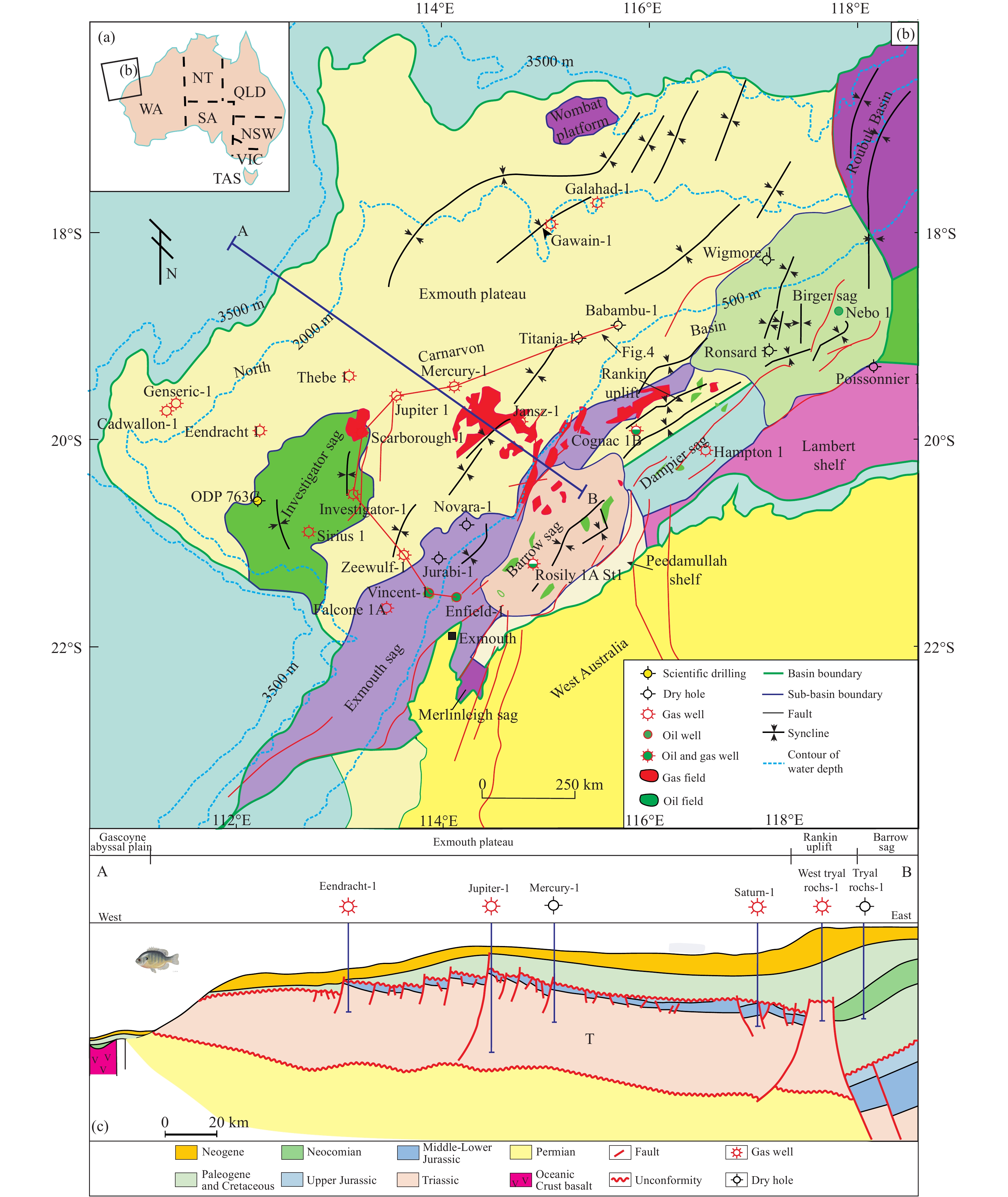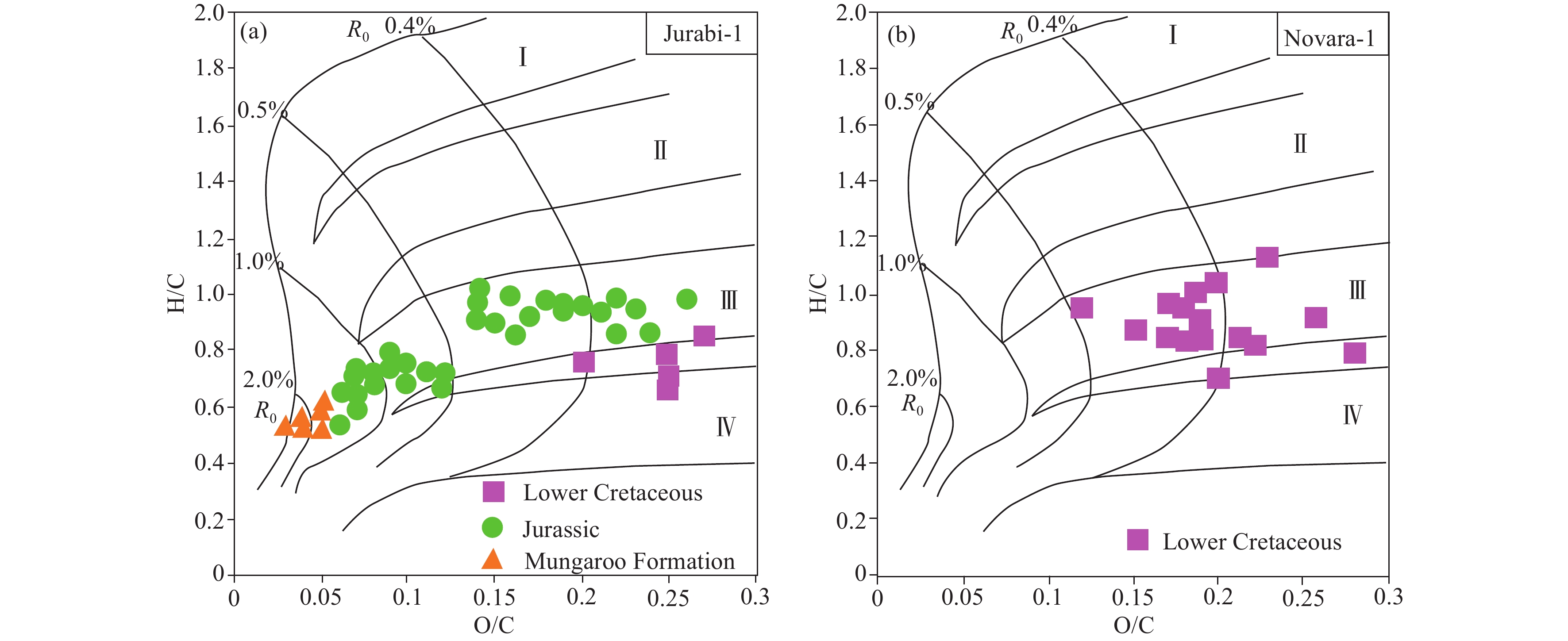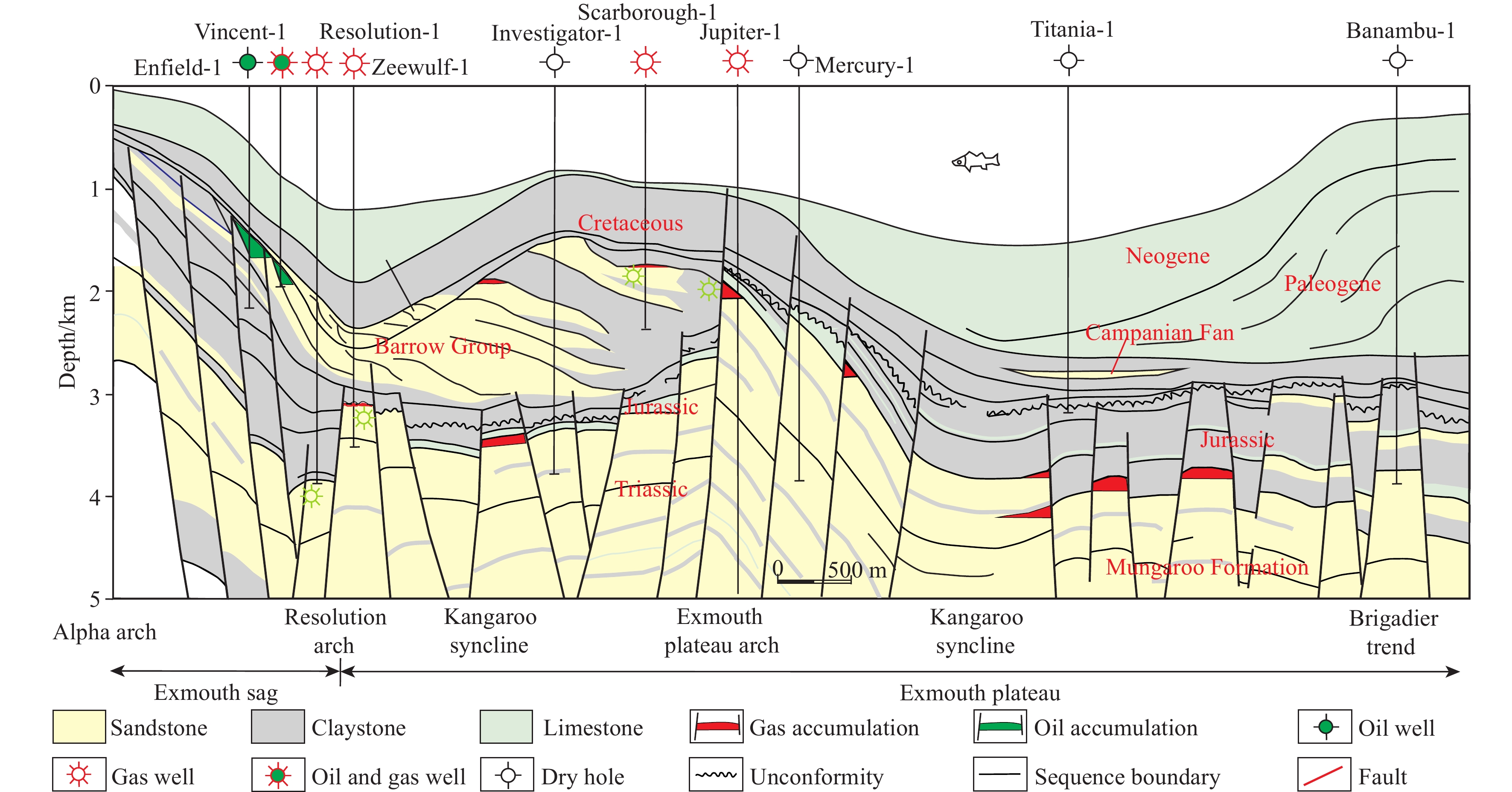| Citation: | Yang-wei Feng, Yan Ren, Gong-cheng Zhang, Hong-jun Qu, 2020. Petroleum geology and exploration direction of gas province in deepwater area of North Carnarvon Basin, Australia, China Geology, 3, 623-632. doi: 10.31035/cg2020064 |
Petroleum geology and exploration direction of gas province in deepwater area of North Carnarvon Basin, Australia
-
Abstract
North Carnarvon Basin is a gas province with minor oily sweet spots in deepwater area with water depth more than 500 m, which is one of the hot spots of global petroleum exploration for its series of giant hydrocarbon discoveries in recent years. However, the degree of oil and gas exploration in deepwater area is still low, and the conditions for oil and gas accumulation are not clear. Based on the current exploration situation and latest database of fields, applying multidisciplinary analysis of hydrocarbon geology, hydrocarbon accumulation elements and its exploration direction of North Carnarvon Basin in deepwater area are analyzed. The results show that there are three sets of main source rocks in deepwater area of North Carnarvon Basin, which are Triassic marine shale in Locker Formation and delta coal-bearing mudstone with thin carbonaceous mudstone in Mungaroo Formation, Lower–Middle Jurassic paralic carbargilite and coal measure strata in Athol Formation and Murat Formation, Cretaceous delta mudstone in Barrow Group and marine shale in Muderong Formation. Most source rock samples show gas-prone capability. The coarse sandstone of delta facies in Middle–Upper Triassic Mungaroo Formation is the most important reservoir in deepwater area, Lower Cretaceous Barrow Group deep-water gravity flow or underwater fan turbidite sandstone is the secondly main reservoir. Lower Cretaceous marine shale in Muderong Formation is most important regional caprock. Triassic mudstone in Mungaroo Formation is an important interlayer caprock in deepwater area. There are two main reservoir accumulation assemblages in deepwater area, one is Triassic structural-unconformity plane reservoir accumulation assemblage of Locker Formation to Mungaroo Formation, and the other is Lower–Middle Jurassic Athol Formation and Murat Formation–Lower Cretaceous stratigraphic lithology-structural reservoir accumulation assemblage of Barrow Group to Muderong Formation. There are three main control factors of hydrocarbon Accumulation: One is coupling of source and seal control hydrocarbon distribution area, the second is multi-stage large wave dominated deltas dominate accumulation zone, the third is direction of hydrocarbon migration and accumulation in hydrocarbon-rich generation depression was controlled by overpressure. The south of Exmouth platform in deepwater area is adjacent to hydrocarbon rich depression zone, reservoir assemblage is characterized by “near source rocks, excellent reservoir facies, high position and excellent caprocks”, which is the main battlefield of deepwater oil and gas exploration in North Carnarvon Basin at present. There are a lot of fault block traps in the northern structural belt of Exmouth platform, and the favorable sedimentary facies belt at the far end of delta plain in Mungaroo Formation is widely distributed, which is the next favorable exploration zone. The Lower Cretaceous, which is located at the concave edge uplift adjacent to the investigator depression and the Exmouth platform, also has a certain exploration prospect in northwest of deepwater area.
-

-
References
[1] Anell I, Wallace MW. 2020. A fine balance: Accommodation dominated control of contemporaneous cool-carbonate shelf-edge clinoforms and tropical reef-margin trajectories, North Carnarvon Basin, Northwestern Australia. Sedimentology, 67(1), 96–117. doi: 10.1111/sed.12628 [2] Bai GP, Yin JY. 2007. Petroleum geological features and exploration potential analysis of North Carnavon Basin, Australia. Petroleum Geology and Experiment, 29(3), 251–258. doi: 10.1016/S1876-3804(11)60008-6 [3] Bradshaw M. 2008. Review of the 2008 offshore petroleum exploration release areas. The Australian Petroleum Production and Exploration Association Journal, 48(1), 359–370. doi: 10.1071/AJ07025 [4] Bussell WR, Jablonski D, Enman T, Wilson MJ, Bint AN. 2001. Deepwater exploration: North Western Australia compared with Gulf of Mexico and Mauritania. The Australian Petroleum Production and Exploration Association Journal, 41(1), 289–320. doi: 10.1071/aj00014 [5] Dixon M, Morgan R, Goodall J, Van Denberg M. 2012. Higher-resolution palynostratigraphy of the Norian-Carnian (Triassic) Upper Mungaroo Formation, offshore Carnarvon Basin. The Australian Petroleum Production and Exploration Association Journal, 52, 1–6. doi: 10.1071/AJ11097 [6] Doré AG, Stewart IC. 2002. Similarities and differences in the tectonics of two passive margins: The Northeast Atlantic Margin and the Australian North West Shelf. In: Keep M, Moss S (Eds.). The Sedimentary Basins of Western Australia 3. Perth, WA: Proceedings of the Petroleum Exploration Society of Australia Symposium, 89–117. [7] Felton EA, Miyazaki S, Dowling L, Pain L, Vuckovic V, le Poidevin SR. 1992. Carnarvon Basin, W.A., Bureau of Resource Sciences, Australian Petroleum Accumulations Report 8. Canberra: Petroleum Resource Branch, 1–224. [8] Feng YW, Qu HJ, Yang CY. 2012. Main controlling factors for hydrocarbon accumulation in North West Shelf of Australia and its favorable exploration direction. Journal of Central South University: Science and technology, 43(6), 2259–2268 (in Chinese with English abstract). doi: ZNGD.0.2012-06-036 [9] Feng YW, Qu HJ, Zhang GC, Pu RH. 2017a. Seismic interpretation and exploration direction of Miocene Meishan formation reef in Southern Qiongdongnan Basin, Northern South China Sea. Journal of Palaeogeography, 6(3), 206–218. doi: 10.1016/j.jop.2017.05.002 [10] Feng YW, Qu HJ, Zhang GC, Fan YH, Guan LQ, Lei L. 2010. Mesozoic source-reservoir-seal assemblage characteristics in the northwest Shelf of Australia. Marine Geology Letter, 26(6), 16–23 (in Chinese with English abstract). doi: 1009-2722(2010)06-0016-08 [11] Feng YW, Qu HJ, Zhang GC, Fan YH, Guan LQ. 2011a. Hydrocarbon geology features of deepwater basins on northwest shelf of Australia. Marine Geology and Quaternary Geology, 31(4), 131–140 (in Chinese with English abstract). doi: 10.3969/j.issn.1000-7849.2011.06.014 [12] Feng YW, Qu HJ, Zhang GC, Zheng YR. 2011b. Hydrocarbon distribution of deepwater basins in Northwest shelf of Australia. Geological Science and Technology Information, 30(6), 99–104 (in Chinese with English abstract). doi: DZKQ.0.2011-06-014 [13] Feng YW, Zhang GC. 2017b. Tectonic evolution and controls on source rock development in global deep-water area at passive continental margin. Marine Origin Petroleum Geology, 22(1), 14–24 (in Chinese with English abstract). doi: 10.3969/j.issn.1672-9854.2017.01.002 [14] Gartrell A, Torres J, Dixon M, Keep M. 2016. Mesozoic rift onset and its impact on the sequence stratigraphic architecture of the Northern Carnarvon Basin. The Australian Petroleum Production and Exploration Association Journal, 56(1), 143–158. doi: 10.1071/AJ15012 [15] Geoscience Australia. 2010. Australian Energy Resource Assessment. Canberra: Australian Energy Resource Assessment, 41–130. [16] Hefti J, Dewing S, Jenkins C, Arnold A, Korn BE. 2006. Improvements in seismic imaging, Io Jansz gas field North West shelf, Australia. The Australian Petroleum Production and Exploration Association Journal, 46(1), 135–160. doi: 10.1071/aj05009 [17] Heldreich G, Redfern J, Legler B, Gerdes K, Williams BP. 2017. Challenges in characterizing subsurface paralic reservoir geometries: A detailed case study of the Mungaroo Formation, North West shelf, Australia. Geological Society of London Special Publication, 444, 59–108. doi: 10.1144/SP444.13 [18] Huang JY. 2011. Recent developments at foreign oil companies. International Petroleum Economics, 19(6), 96–99 (in Chinese with English abstract). doi: GJJJ.0.2011-08-023 [19] I'Anson A, Elders C, McHarg S. 2019. Marginal fault systems of the Northern Carnarvon Basin: Evidence for multiple Palaeozoic extension events, North-West Shelf, Australia. Marine and Petroleum Geology, 101, 211–229. doi: 10.1016/j.marpetgeo.2018.11.040 [20] Jenkins CC, Maughan DM, Acton JH, Duckett A, Korn BE, Teakle RP. 2003. The Jansz gas field, Carnarvon basin, Australia. The Australian Petroleum Production and Exploration Association Journal, 43(1), 303–324. doi: 10.1071/aj02016 [21] Jin QH. 2006. Petroleum in deep water is major prospecting hot spot nowadays. Scientific Chinese, (11), 18–20 (in Chinese with English abstract). doi: KXZG.0.2006-11-004 [22] Kang YZ. 2019. The main causes of global land and sea changes. Geology in China, 46(6), 1253–1258 (in Chinese with English abstract). doi: 10.12029/gc20190601 [23] Li JF, Ye JL, Qin XW, Qiu HJ, Wu NY, Lu HL, Xie WW, Lu JA, Peng F, Xu ZQ, Lu C, Kuang ZG, Wei JG, Liang QY, Lu HF, Kou BB. 2018. The first offshore natural gas hydrate production test in South China Sea. China Geology, 1, 5–16. [24] Liu H, Yu EL. 2014. Recent developments at foreign oil companies. International Petroleum Economics, 22(8), 101–104 (in Chinese with English abstract). [25] Longley IM, Buessenschuett C, Clydsdale L, Cubitt CJ, Davis RC, Johnson MK, Marshall NM, Murray AP, Somerville R, Spry TB, Thompson NB. 2002. The North West Shelf of Australia- a Woodside perspective. In: Keep M, Moss S (Eds.). The Sedimentary Basins of Western Australia 3. Perth, WA: Proceedings of the Petroleum Exploration Society of Australia Symposium, 27–88. [26] Mantle DJ, RidingJames B, Hannaford C. 2020. Late Triassic dinoflagellate cysts from the Northern Carnarvon Basin, Western Australia. Review of Palaeobotany and Palynology, 281, 1–53. doi: 10.1016/j.revpalbo.2020.104254 [27] Martin J, Fernandes AM, Pickering J, Howes N, Mann S, Mcneil K. 2018. The stratigraphically preserved signature of persistent backwater dynamics in a large paleodelta system: The Mungaroo Formation, North West Shelf, Australia. Journal of Sedimentary Research, 88, 850–872. doi: 10.2110/jsr.2018.38 [28] McArdle NJ, Iacopini D, KunleDare MA, Paton GS. 2014. The use of geologic expression workflows for basin scale reconnaissance: A case study from the Exmouth Subbasin, North Carnarvon Basin, northwestern Australia. Interpretation, 2(1), 163–177. doi: 10.1190/INT-2013-0112.1 [29] Palmer N, Theologou P, Korn BE, Munckton T. 2005. The wheatstone gas discovery: A case study of Tithonian and late Trissic fluvial reservoirs. The Australian Petroleum Production and Exploration Association Journal, 45(1), 333–348. doi: 10.1071/AJ04027 [30] Paumard V, Bourget J, Payenberg T, Bruce AR, George AD, Lang S, Posamentier HW, Peyrot D. 2018. Controls on shelf-margin architecture and sediment partitioning during a syn-rift to post-rift transition: Insights from the Barrow Group (Northern Carnarvon Basin, North West Shelf, Australia). Earth-Science Reviews, 177, 643–677. doi: 10.1016/j.earscirev.2017.11.026 [31] Pettingill HS, Weimer P. 2001. World-wide deepwater exploration and production: Past, present and future. Offshore Technology Conference, Houston, Texas, 6–9 May. [32] Seggie RJ, Lang SC, Marshall NM, Cubitt CJ, Alsop D, Kirk R, Twartz S. 2007. Integrated multi-disciplinary analysis of the Rankin Trend gas reservoirs North West Shelf, Australia. The Australian Petroleum Production and Exploration Association Journal, 47, 53–67. doi: 10.1071/aj06003 [33] Tao CZ, Bai GP, Liu JL, Deng C, Lu XX, Liu HW, Wang DP. 2013. Mesozoic lithofacies palaeogeography and petroleum prospectivity in North Carnarvon Basin, Australia. Journal of Palaeogeography, 2(1), 81–92. doi: 10.3724/SP.J.1261.2013.00019 [34] Thomas B. 2010. New opportunities for offshore petroleum exploration—2010 Acreage Release offers blocks in producing regions and in frontier areas. AUSGEO news, 98, 1–9. https://www.ret.gov.au/Documents/par/index.html. [35] Walker TR. 2007. Deepwater and frontier exploration in Australia- Historical perspectives, present environment and likely future trends. The Australian Petroleum Production and Exploration Association Journal, 47(1), 15–38. doi: 10.1071/aj06001 [36] Wang DS, Wang ZQ, Wang G, Guo XQ, Wu YD. 2019. Characteristics of tectonic deformation of the melange zone in the Lachlan Orogen along eastern coast of Australia. China Geology, 2, 478–492. doi: 10.31035/cg2018131 [37] Xia CC, Zhu HT, Yang XH, Huang Z, Zhuang WJ, Cao XR, Zeng ZW. 2015. Large-scale shallow braided river delta depositional characteristics and depositional pattern of Mungaroo Formation in Late Triassic, North Carnarvon Basin, Australia. Journal of Central South University: Science and Technology, 46(8), 2983–2990 (in Chinese with English abstract). doi: 10.11817/j.issn.1672-7207.2015.08.031 [38] Xu XM, Hu XL, Zhao RM, Yang XH, Li D. 2014. Exploration potential of Triassic Mungaroo formation, North Carnarvon basin, Australia. Geological Science and Technology Information, 33(6), 119–127 (in Chinese with English abstract). doi: DZKQ.0.2014-06-017 [39] Yang XM, Elders C. 2016. The Mesozoic structural evolution of the Gorgon Platform, North Carnarvon Basin, Australia. Australian Journal of Earth Sciences, 63(6), 755–770. doi: 10.1080/08120099.2016.1243579 [40] Yu EL. 2013. Recent developments at foreign oil companies. International Petroleum Economics, 21(5), 101–104 (in Chinese with English abstract). doi: 10.3969/j.issn.1004-7298.2014.06.016 [41] Zeng ZW, Zhu HT, Yang XH, Zeng HL, Hu XL, Xia CC. 2019. The Pangaea Megamonsoon records: Evidence from the Triassic Mungaroo Formation, Northwest Shelf of Australia. Gondwana Research, 69, 1–24. doi: 10.1016/j.gr.2018.11.015 [42] Zhang GC, Qu HJ, Feng YW. 2015. An Introduction to the Petroleum Geology of Deepwater Settings. Beijing: Science Press (in Chinese). [43] Zhang GC, Qu HJ, Zhang FL, Chen S, Yang HC, Zhao Z, Zhao C. 2019. Recent major discoveries of oil and gas in global deepwaters and enlightenment. Acta Petrolei Sinica, 40(1), 1–34 (in Chinese with English abstract). doi: 10.7623/syxb201901001 [44] Zhang GX, Yang Z, Zhang L, Yan W, Qiang KS. 2018. Study of overthrust nappe structure and its geodynamic mechanism along the southeastern margin of Nansha Trough. China Geology, 1, 459–465. doi: 10.31035/cg2018060 [45] Zhang JQ, Qian GH, Guo NF. 2008. Large Sedimentary Basins of Australia and Hydrocarbon Accumulation. Beijing, Petroleum Industry Press, 88-128 (in Chinese with English abstract). [46] Zhu WL, Hu P, Ji HQ. 2013. Australian Petroliferous Basin. Beijing, Science Press (in Chinese). [47] Zou CN, Zhang GY, Tao SZ, Hu SY, Li XD, Li JZ, Dong DZ, Zhu RK, Yuan XJ, Hou LH, Qu H, Zhao X, Jia JH, Gao XH, Guo QL, Wang L, Li XJ. 2010. Geological features, major discoveries and unconventional petroleum geology in the global petroleum exploration. Petroleum Exploration and Development, 37(2), 129–145. doi: 10.1016/S1876-3804(10)60021-3 -
Access History

-
Figure 1.
Comprehensive geological map of North Carnarvon basin (modified from Zhu WL et al., 2013; Thomas B, 2010).
-
Figure 2.
Source rock characteristics of Exmouth sub-basin (the well location is shown in Fig. 1).
-
Figure 3.
Source-reservoir-cap assemblage in deepwater area of North Carnarvon Basin.
-
Figure 4.
Hydrocarbon accumulation in deepwater area of North Carnarvon Basin (modified from Bussell WR et al., 2001) (location shown in Fig. 1).
-
Figure 5.
Thickness of Jurassic and Cretaceous strata in deepwater area of North Carnarvon Basin (modified from Longley IM et al., 2002).
-
Figure 6.
The development of Mesozoic multi-stage delta in North Carnarvon Basin (midified from Longley IM, et al., 2002).





 DownLoad:
DownLoad:




